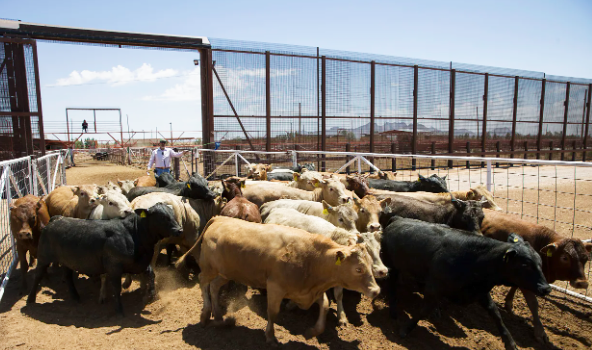Derrell S. Peel, Oklahoma State University
USDA-APHIS has announced a slow phased reopening of the Mexican border for imports of cattle, bison and horses in the coming weeks. Progress has been made in containing the spread of New World Screwworm (NWS) in Mexico with expanded control measures and increased cooperation with Mexican officials. The plan calls for opening ports farthest away from southern Mexico (i.e. Arizona) with the least risk of transporting NWS to and across borders and sequentially reopening ports in New Mexico and Texas between July and September. Each phase of reopening will be contingent on continuing assessment and progress in NWS containment and control in Mexico. The Arizona and New Mexico ports are all at roughly the same latitude with Douglas, AZ the farthest west, roughly 200 miles west of Santa Teresa, NM. The following discussion will use Mexico City as a reference point for relative port locations. NWS affected areas in Mexico are all south of Mexico City.
The first port scheduled to open, on July 7, is Douglas Arizona. Douglas, AZ is located roughly 1230 highway miles from Mexico City and by latitude and longitude is some 828 miles north and roughly 690 miles west. In 2023, the most recent complete year of border cattle trade with Mexico, the Douglas port was the second largest port in volume of cattle crossed and accounted for just under 15 percent of total annual feeder cattle imports. Nogales, AZ, the second largest cattle port in 2023 is not currently scheduled for reopening. In total, Arizona ports accounted for 27.5 percent of total imports of Mexican cattle in 2023.
The Columbus, New Mexico port is scheduled to reopen on July 14. Columbus is about 1209 miles from Mexico City and is roughly 828 miles north and 550 miles west of Mexico City. Columbus was the fourth largest volume port in 2023, with just under 11 percent of total annual imports.
Santa Teresa, New Mexico, located just west of El Paso, Texas, is the largest port for cattle imports and accounted for about 43 percent of total Mexican cattle imports in 2023. The port is scheduled to reopen on July 21. Santa Teresa is roughly 1160 miles from Mexico City and is approximately 828 miles north and 483 miles west of the Mexican capital. The New Mexico ports represented 53.4 percent of Mexican cattle imports in 2023.
The Texas port of Del Rio is scheduled to reopen on August 18. Del Rio is roughly 823 miles from Mexico City and is located roughly 690 miles north and less than 100 miles west of Mexico City. The Del Rio port accounted for less than two percent of total cattle imports from Mexico in 2023.
The port at Laredo, Texas is slated to open on September 15. The port accounted for just over one percent of cattle imports in 2023. This port is closest to southern Mexico, some 700 highway miles from Mexico City and according to latitude and longitude is about 550 miles due north of Mexico City. The Texas ports accounted for just over 19 percent of cattle imports in 2023, including Presidio, Texas, which represented nearly eight percent of total imports and is not currently on the list of ports scheduled to reopen.
In the weeks from early February to May 11, a total of 224,834 Mexican cattle crossed the border. The current list of ports scheduled to reopen accounted for roughly 71 percent of total imports in 2023. Given the remaining weeks of the year and the likelihood that ports will not jump to historic capacity immediately, total possible imports for the year are likely to be significantly reduced for the year. Fewer Mexican cattle were expected this year in any event, compared to the last two years, and with the disruptions thus far, total cattle imports in 2025 may be in the range of 400 to 700 thousand head, depending on how smoothly the reopening process proceeds.
Articles on The Cattle Range are published because of interesting content but don't necessarily reflect the views of The Cattle Range.










